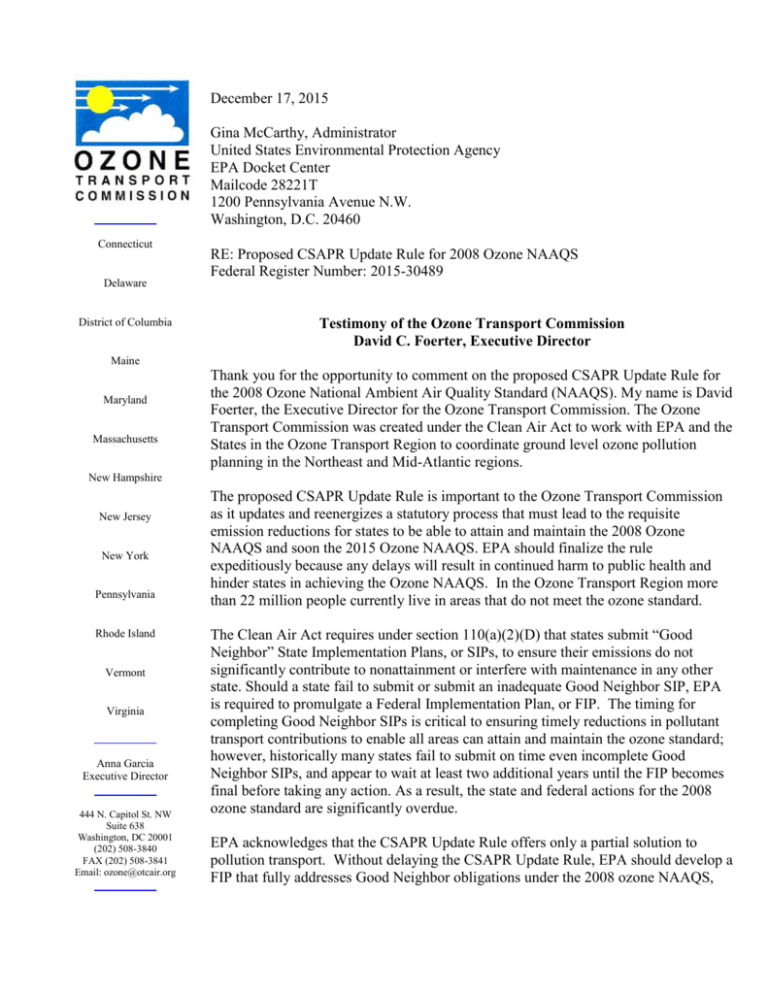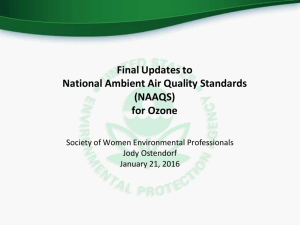Comment on CSAPR Update Rule 12-17-2015
advertisement

December 17, 2015 ___________ Connecticut Delaware District of Columbia Gina McCarthy, Administrator United States Environmental Protection Agency EPA Docket Center Mailcode 28221T 1200 Pennsylvania Avenue N.W. Washington, D.C. 20460 RE: Proposed CSAPR Update Rule for 2008 Ozone NAAQS Federal Register Number: 2015-30489 Testimony of the Ozone Transport Commission David C. Foerter, Executive Director Maine Maryland Massachusetts Thank you for the opportunity to comment on the proposed CSAPR Update Rule for the 2008 Ozone National Ambient Air Quality Standard (NAAQS). My name is David Foerter, the Executive Director for the Ozone Transport Commission. The Ozone Transport Commission was created under the Clean Air Act to work with EPA and the States in the Ozone Transport Region to coordinate ground level ozone pollution planning in the Northeast and Mid-Atlantic regions. New Hampshire New Jersey New York Pennsylvania Rhode Island Vermont Virginia ___________ Anna Garcia Executive Director ___________ 444 N. Capitol St. NW Suite 638 Washington, DC 20001 (202) 508-3840 FAX (202) 508-3841 Email: ozone@otcair.org ___________ The proposed CSAPR Update Rule is important to the Ozone Transport Commission as it updates and reenergizes a statutory process that must lead to the requisite emission reductions for states to be able to attain and maintain the 2008 Ozone NAAQS and soon the 2015 Ozone NAAQS. EPA should finalize the rule expeditiously because any delays will result in continued harm to public health and hinder states in achieving the Ozone NAAQS. In the Ozone Transport Region more than 22 million people currently live in areas that do not meet the ozone standard. The Clean Air Act requires under section 110(a)(2)(D) that states submit “Good Neighbor” State Implementation Plans, or SIPs, to ensure their emissions do not significantly contribute to nonattainment or interfere with maintenance in any other state. Should a state fail to submit or submit an inadequate Good Neighbor SIP, EPA is required to promulgate a Federal Implementation Plan, or FIP. The timing for completing Good Neighbor SIPs is critical to ensuring timely reductions in pollutant transport contributions to enable all areas can attain and maintain the ozone standard; however, historically many states fail to submit on time even incomplete Good Neighbor SIPs, and appear to wait at least two additional years until the FIP becomes final before taking any action. As a result, the state and federal actions for the 2008 ozone standard are significantly overdue. EPA acknowledges that the CSAPR Update Rule offers only a partial solution to pollution transport. Without delaying the CSAPR Update Rule, EPA should develop a FIP that fully addresses Good Neighbor obligations under the 2008 ozone NAAQS, including the consideration of potential emission reductions from high-emitting sources other than electric generating units. Lastly, in order for OTC States to achieve the benefit of the 2015 Ozone NAAQS, we urge EPA to proceed with development of guidance for states to address their “Good Neighbor” obligations under the 70 ppb standard in parallel with finalizing requirements for the 75 ppb rule. The OTC and some of its individual member states intend to provide additional written comment in the near future. Again I thank you for the opportunity to submit these comments and look forward to working together with EPA to ensure the residents of the Ozone Transport Region are breathing clean healthy air. # # #







